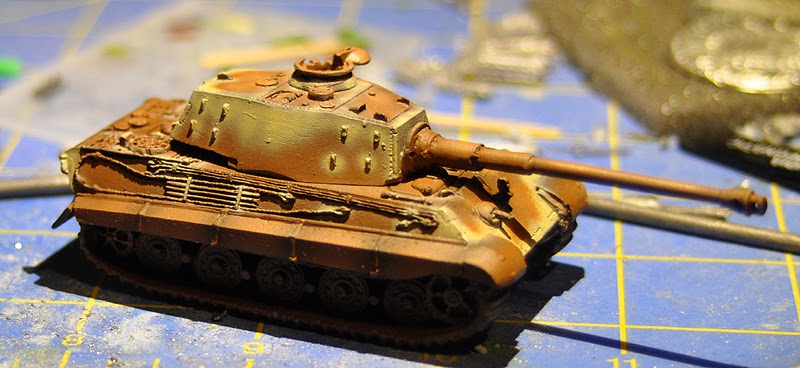First the king tiger progress. In previous blogs, I've detailed the one tank in primer red as well as those in the octopus scheme. I'm now working on the ones that will be in Hinterhalt-Tarnung or Ambush camouflage. For these vehicles I've started with a base dunkelgelb which I've then modulated using AK interactive modulating paints:
Ambush camouflage comes in several varieties, but the version I'm trying to replicate is hard edged. I therefore pulled out the Panzer putty again and began the process of masking the areas I wanted to remain yellow. Next I painted the olivgrun, again using AK interactive modulating paints to preserve the overall modulation of the piece. Once that is dry, you guessed it, more Panzer Putty and then it is on to the rotbraun.
The Schurtzen are getting the same treatment as the vehicles themselves. Unlike the King Tigers, I wanted to go with a blotchy freehand over-spray of red-brown and olive green. So I used the Ammo of Mig 1943-1945 wargaming set and the overspray paints there. I found the dark yellow modulation paints in this particular set to be a little brighter than I was used to, so I'm going to have to try that again with lighter modulation coats. So far I'm happy with how the schemes are coming out, and once weathered I think they're going to look spot on for battle-weary training panzers.
As I mentioned before, I'm also trying similar techniques with the Nebelwerfers and flak guns. They'll need some additional hand painting as the surfaces are very irregular, but for the initial shading I think the modulation techniques will work fine. First up are the Nebelwerfers. Right now they're just in the base coat, which as you can see is quite dark.
I've made it further with the flak guns, I was able to go ahead and start the modulation process with them. There are whole areas I skipped simply because I know they will be covered by other parts once the full miniature is assembled.
After the modulation of the panzer dark yellow - I went ahead and overs-prayed the gun shield with the red brown and olive green while I was painting the Ersatz unit above. The end effect looks good so far. The gun shields for the flak guns will, as well as the cradles will get some chipping and other effects.
At this point I've gone forward and gloss coated the first three King Tigers as well as the Ersatz squad and the flak guns. I've brought them inside and have started the pin washes with a mix of AK and Ammo of MIG products. I'm hoping to have photos that progress soon. I've also just discovered that the tanks for my October army are not quite together yet, so I'm going to have to take a short break and finish building a couple of Tiger Tanks and one Panzer III Ausf N. Look for those in an upcoming blog as well!


























